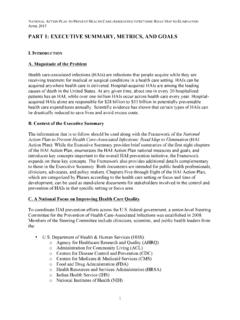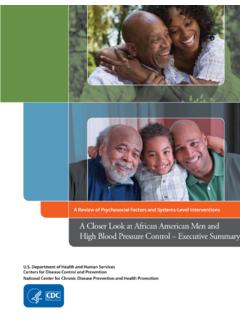Transcription of FDNY Report final - Welcome to NYC.gov | City of New York
1 executive summary The terrorist attacks on the World Trade Center on September 11, 2001 reshaped expectations about future threats and created a new urgency to increase preparedness. At the Fire Department's request, McKinsey & Company spent five months working with Department personnel to develop recommendations for change to enhance the FDNY's preparedness. These recommendations stem from the lessons that emerged from our detailed review of the Department's response on September 11, and from the many interviews we conducted with FDNY personnel and with other emergency service agencies, experts in fire operations, the military, and technology vendors. Many of the recommendations represent the joint efforts of several McKinsey-FDNY.
2 Task forces involving approximately 50 FDNY members. This executive summary contains recommendations to the Fire Department in these key areas: operations, planning and management, communications and technology, and family and member support As background, the executive summary also contains a description of the key events related to these areas during the Department's response to the attack on September 11. FIRE AND EMS RESPONSE: KEY EVENTS OF SEPTEMBER 11. The FDNY's response to the attack began at 8:46 , the moment the first plane hit Tower 1 of the World Trade Center. The FDNY's First Battalion Chief witnessed the first crash from a nearby street and was the first arriving chief officer on the scene. In accordance with FDNY protocols, he established an Incident Command Post2 in the lobby of World Trade Center 1 (WTC 1) at approximately 8:50 1 Family and member support services are the infrastructure and processes used to notify families of death or injury to FDNY personnel, along with post-incident peer and family counseling and support.
3 2 The Incident Command Post is the location from which all aspects of an incident response are managed. 5. Chief of Department establishes command At about 9:00 , the Chief of Department took over as Incident Commander. At that time, he moved the Incident Command Post from the lobby of WTC 1 to a spot across West Street, an eight-lane highway, because of falling debris and other safety concerns. Chief officers considered a limited, localized collapse of the towers possible, but did not think that they would collapse entirely. After the Incident Command Post was moved to West Street, several fire chiefs remained behind in the lobby of WTC 1, which became an Operations Post for fire units operating in that building. Their presence in the lobby was necessary so they would have access to important building systems, such as controls for alarms, elevators, and communications systems.
4 Within minutes, the chief officers in WTC 1 decided to focus efforts on rescue and evacuation. They sent firefighters up into the building to help the hundreds of people trapped in elevators, stairwells, and rooms, along with those who were unable to evacuate because they were injured. They also ordered firefighters to make sure that floors were fully evacuated. At the same time, EMS commanders began to set up geographic areas around the scene where ambulances could be staged and patients triaged, treated and transported to hospitals. The EMS Assistant Chief of Operations assumed overall EMS Command at the Incident Command Post, reporting to the Incident Commander. At 9:03 , the second plane hit World Trade Center Tower 2 (WTC 2). Chiefs immediately called in additional Fire units3 and deployed units from WTC 1.
5 Chiefs designate staging areas As the mobilization escalated, dispatchers instructed responding Fire units to Report to staging areas 4 that senior chiefs had designated near the World Trade Center. However, as these units approached the area, many failed to Report to the staging areas and instead proceeded directly to the tower lobbies or other parts of the incident area. As a result, senior chiefs could not accurately track the whereabouts of all units. In addition, the failure to stage prevented Fire units from getting necessary information and orientation before going into the towers. For instance, several units that were not familiar with the World Trade Center layout 3 A Fire unit is a group of firefighters who have the same assignment, an engine or ladder company.
6 Most units include four to five firefighters and one officer. 4 A staging area is a resource management area in close proximity to the incident. Units directed to stage are expected to respond to the staging area and await further deployment instructions. 6. had problems differentiating WTC 1 from WTC 2. Also, because some units did not stage and chiefs were unsure of their location, additional units, that might not have been required at that time, were deployed to the incident. Units arriving at the lobby of WTC 1 checked in with the chief officers at the Operations Post to obtain their assignments. Chief officers sent these units up into the building in an orderly, controlled way. We believe the same happened in WTC 2. Communications limitations emerge A number of communications difficulties hindered FDNY chief officers as they coordinated the response.
7 For instance, problems with radio communications left the chief officers in the lobby of WTC 1, and probably those in WTC 2, with little reliable information on the progress or status of many of the units they had sent up into the buildings. The portable radios that were used by the FDNY on September 11 do not work reliably in high-rise buildings without having their signals amplified and rebroadcast by a repeater system. The World Trade Center had such a system, but chief officers deemed it inoperable early in the response after they tested it in the lobby of WTC. 1. With the repeater malfunctioning, the chiefs in the lobby of WTC 1 would not have been able to communicate with any units whose radios were tuned to the repeater channel, even if such units were just a few feet away from them.
8 On the other hand, the command and tactical channels5 on these radios do support some, albeit unreliable, communications in high rises. Therefore, the chiefs decided to use their command and tactical channels for operations in WTC 1. Radio communications between chief officers in the lobby of WTC 1 and the units they sent in the building we re sporadic. The chiefs were able to get through to some units sometimes, but not others. Some units acknowledged receiving radio communications some times, but not others. This left the chiefs not knowing whether their messages failed to get through, whether the units failed to acknowledge because they were busy with rescue operations, or whether the units did acknowledge, but the acknowledgement did not get through.
9 Because information about civilians in distress continued to reach the Operations Post in the lobby, the chief officers decided to continue their attempts to evacuate and rescue civilians, despite the communications difficulties. We believe that the chiefs and units in WTC 2 faced similar communications problems. 5 Tactical radio channels are used for on-scene communications among chiefs and the units they command. Chiefs provide directions to units on this channel while units provide status reports to the chiefs and each other and request assistance. Command channels are used by chiefs at an incident to communicate with each other. 7. Chief officers in the lobbies of WTC 1 and WTC 2 also had very little reliable information on what was happening outside the towers.
10 They had no reliable sources of intelligence, and had no external information about the overall status of the incident area, the condition of the towers, or the progression of the fires. For example, they had no access to television reports or reports from an NYPD. helicopter that was hovering above the towers. This lack of information hindered their ability to evaluate the overall situation. EMS chiefs and ambulances also faced communications problems due largely to radio traffic congestion. This occurred partly because two EMS channels are on the same frequency: the command channel, normally reserved for chief officers, and the citywide channel, normally used by ambulances and EMS Dispatch. This congestion problem was exacerbated by a number of ambulances that repeatedly asked to be dispatched to the World Trade Center.















